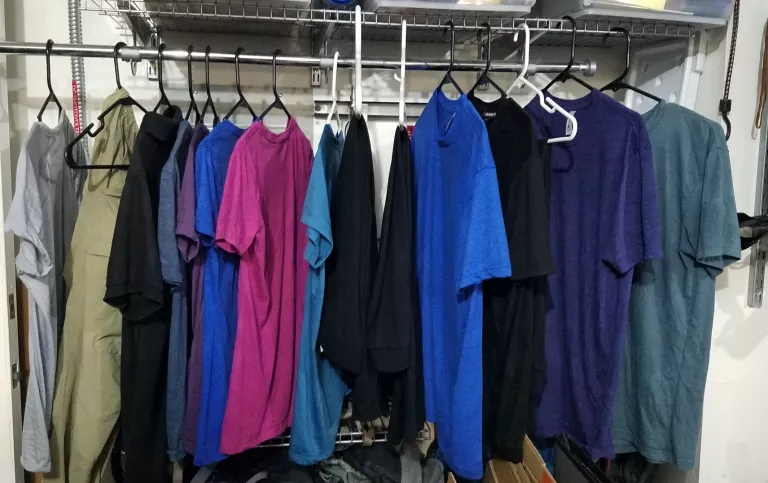Editor’s note: We continue to feature specific climate action ideas authored by UCSB lecturer in environmental studies, Deborah Williams. This report is on air-drying laundry to save money and extend the life of clothes.
There are so many ways we can reduce our carbon footprint and save money; one often overlooked area is our laundry. Dryers have a significant carbon footprint and are usually one of the top three energy-hungry appliances (after refrigerators and washing machines) in our homes. https://www.greenamerica.org/green-living/ditch-your-dryer

Our climate change scribe, Deborah Williams, practices the information she conveys. In this case, she took a photo of her own clothes hanging up to dry in her garage, saving money and energy. Photo by Deborah Williams.
An average household can reduce its carbon footprint by 2,400 pounds per year by air drying clothes. https://www.thespruce.com/reasons-to-line-dry-laundry-2145997
Because clothes dryers represent around 5.8% of residential electricity use, we can also save money by energy-free air drying. https://theecohub.ca/here-are-5-ways-to-air-dry-your-clothes-no-matter-where-you-live/
Dryer usage is hard on most fabrics due to friction and heat. Air-drying is better for fabrics, helping to keep their color, shape and texture intact longer.
According to Cosette Joyner Martinez, an associate professor at Oklahoma State University, “The lifespan extension that you get with [air drying] is pretty incredible.” https://www.washingtonpost.com/climate-solutions/2023/05/14/laundry-air-dry-energy-saving/
The material in our dryer lint filter is evidence that our clothes are breaking down in the dryer. Inside air drying can also increase our home’s humidity which is especially positive in the winter months. https://www.washingtonpost.com/climate-solutions/2023/05/14/laundry-air-dry-energy-saving/
Washing clothes in cold water most of the time will also save money and reduce emissions because up to 90% of the energy use goes toward heating the water. You can save up to 864 pounds of emissions per year by washing four out of five loads in cold water. https://www.nytimes.com/2019/10/02/climate/nyt-climate-newsletter-laundry.html
There are several straightforward steps to achieving a more earth friendly and money-saving way to do laundry. First, identify where in your house and potentially outside you can set up a system to hang wet clothes. If you don’t have a dedicated laundry room, identify another part of your home such as a bathroom, bedroom or even the garage to set up some portable or retractable clothes drying racks/ hangers. We use the garage. Most of the year, there is also the potential to hang clothes outside to dry, which has additional benefits. Drying outside makes clothes smell fresher, increases daily steps/exercise, reduces hard-to-remove smells, and helps to whiten and disinfect laundry. https://www.thespruce.com/reasons-to-line-dry-laundry-2145997
Next, determine what type of drying implements will work in your situation. The Eco Hub provides lots of suggestions about what is available and how to hang up wet clothes for the best drying results. https://theecohub.com/here-are-5-ways-to-air-dry-your-clothes-no-matter-where-you-live/
Other sites that list drying implement options include Best Clotheslines for Air Drying Clothes of 2023 and Urban Clotheslines. https://ohsospotless.com/clotheslines/ and https://urbanclotheslines.com/
Finally, today’s detergents are formulated to clean clothes in all temperatures and using cold saves the energy and money. Like other carbon reduction strategies discussed in this bi-monthly column, carbon footprint reduction strategies for laundry are win-win.
By Deborah Williams